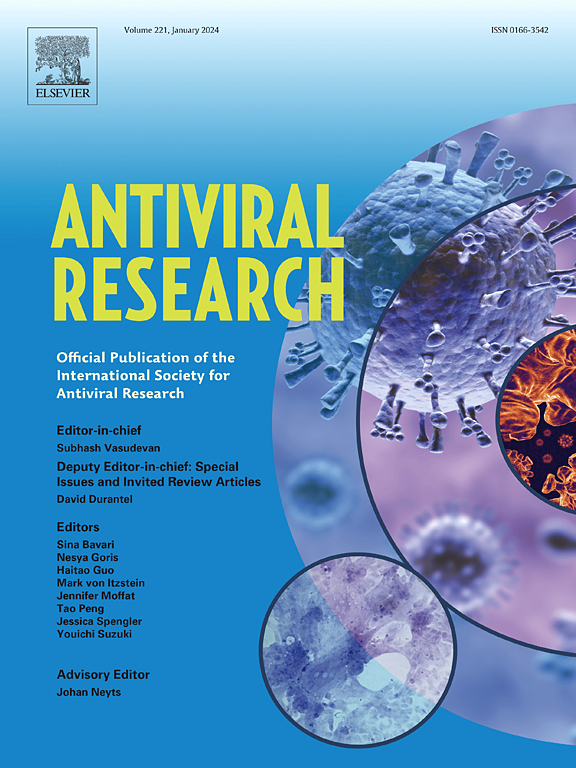用新的设计策略开发基于脂肽的 HIV-1/2 融合抑制剂,靶向 gp41 口袋位点。
IF 4.5
2区 医学
Q1 PHARMACOLOGY & PHARMACY
引用次数: 0
摘要
新近的研究表明,脂质连接是设计基于多肽的病毒融合抑制剂的重要策略,所谓的脂肽可大大提高抗病毒活性。在设计脂肽时,肽序列和脂质分子之间通常需要一个灵活的连接物,大多是短聚乙二醇或甘氨酸-丝氨酸序列。最近,我们发现以螺旋促进氨基酸序列 "EAAAK "作为刚性连接体是设计 SARS-CoV-2 融合抑制脂肽的一种更有效的方法。在这项研究中,我们全面描述了不同连接体在 HIV 融合抑制剂中的功能特性。以主要针对gp41口袋位点的短肽抑制剂2P23为设计模板,产生了一组胆固醇修饰的脂肽。在抑制 HIV-1 感染方面,刚性连接体的脂肽抑制剂远优于柔性连接体的抑制剂,如带有 "EAAAK "连接体的 LP-37 和带有重复 "EP "氨基酸序列的 LP-39。这两种脂肽对 HIV-2 和猿免疫缺陷病毒(SIV)都有很强的抑制作用。令人欣喜的是,LP-37 显示出很高的α-异构性、热稳定性和与目标模拟肽的结合能力,并且在温度、蛋白水解酶或人类血清的作用下具有代谢稳定性。总之,我们的研究验证了设计病毒融合抑制剂的通用策略,并为药物开发提供了一种新型 HIV 融合抑制剂。本文章由计算机程序翻译,如有差异,请以英文原文为准。
Development of lipopeptide-based HIV-1/2 fusion inhibitors targeting the gp41 pocket site with a new design strategy
Emerging studies demonstrate that lipid conjugation is a vital strategy for designing peptide-based viral fusion inhibitors, and the so-called lipopeptides exhibit greatly improved antiviral activity. In the design of lipopeptides, a flexible linker between the peptide sequence and lipid molecule is generally required, mostly with a short polyethylene glycol or glycine-serine sequence. Very recently, we discovered that the helix-facilitating amino acid sequence “EAAAK” as a rigid linker is a more efficient method in the design of SARS-CoV-2 fusion inhibitory lipopeptides. In this study, we comprehensively characterized the functionalities of different linkers in HIV fusion inhibitors. A short-peptide inhibitor 2P23, which mainly targets the gp41 pocket site, was used as a design template, generating a group of cholesterol-modified lipopeptides. In the inhibition of HIV-1 infection, the lipopeptide inhibitors with a rigid linker were much superior than those with the flexible linkers, as indicated by LP-37 with the “EAAAK” linker and LP-39 with the repeated “EP” amino acid sequences. Both lipopeptides were very potent inhibitors of HIV-2 and simian immunodeficiency (SIV) either. Promisingly, LP-37 displayed high α-helicity, thermostability and binding ability to a target-mimic peptide, and it was metabolically stable when treated with temperature, proteolytic enzymes or human sera. Taken together, our studies have verified a universal strategy for designing viral fusion inhibitors and offered a novel HIV fusion inhibitor for drug development.
求助全文
通过发布文献求助,成功后即可免费获取论文全文。
去求助
来源期刊

Antiviral research
医学-病毒学
CiteScore
17.10
自引率
3.90%
发文量
157
审稿时长
34 days
期刊介绍:
Antiviral Research is a journal that focuses on various aspects of controlling viral infections in both humans and animals. It is a platform for publishing research reports, short communications, review articles, and commentaries. The journal covers a wide range of topics including antiviral drugs, antibodies, and host-response modifiers. These topics encompass their synthesis, in vitro and in vivo testing, as well as mechanisms of action. Additionally, the journal also publishes studies on the development of new or improved vaccines against viral infections in humans. It delves into assessing the safety of drugs and vaccines, tracking the evolution of drug or vaccine-resistant viruses, and developing effective countermeasures. Another area of interest includes the identification and validation of new drug targets. The journal further explores laboratory animal models of viral diseases, investigates the pathogenesis of viral diseases, and examines the mechanisms by which viruses avoid host immune responses.
 求助内容:
求助内容: 应助结果提醒方式:
应助结果提醒方式:


